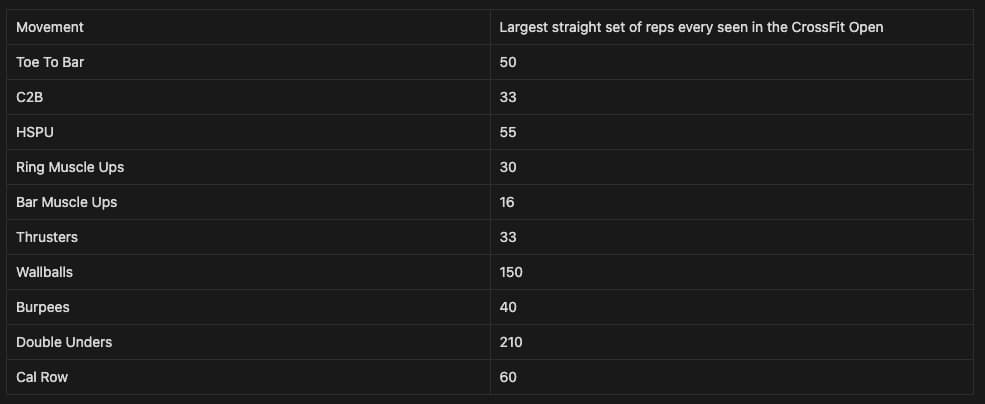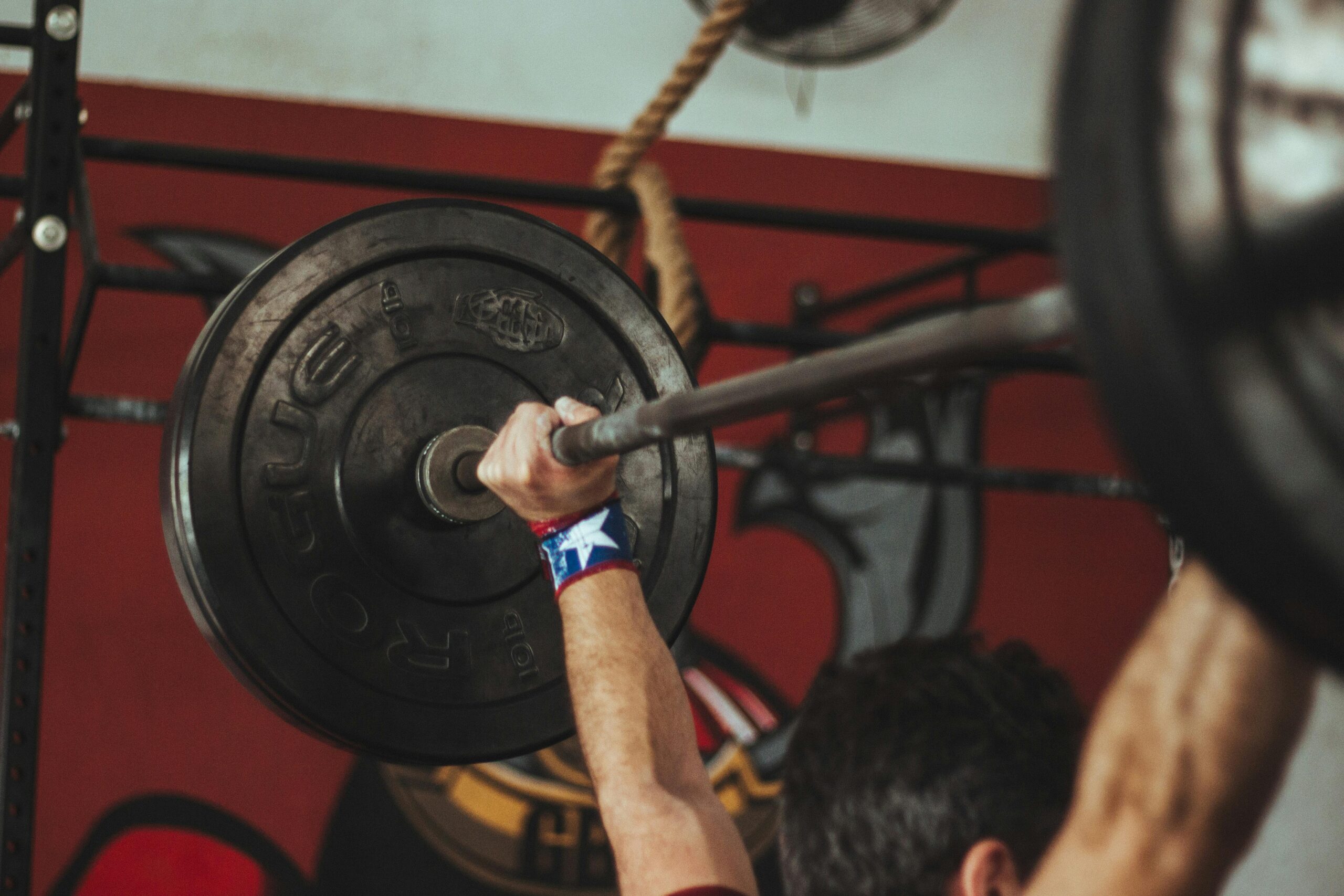At Apex, we’re passionate about data, especially with the 2024 CrossFit Open on the horizon. We’re excited to share insights from our data collection to help your Open preparation and performance.
Our dataset offers valuable insights for athletes at all levels, from novices to those aiming to rank in the top 1% globally (the 99th percentile).
Below, you’ll discover data on:
- Prevalent Movements in the CrossFit Open: An overview of the most common movements encountered in past Opens.
- Elite Performance Benchmarks: The average repetitions elite athletes (top 1% globally) complete in workouts featuring these movements.
- Peak Volumes: The maximum workload elite athletes have managed in a single workout with these movements.
- Largest straight set of reps: The largest single set of repetitions recorded for these movements, like completing 30 consecutive ring muscle ups before transitioning to another exercise.
The Significance of Historical Data
While history doesn’t guarantee future outcomes, it provides insightful trends that can shape our expectations. This historical data is a treasure trove for strategizing your training focus to maximize success in the upcoming CrossFit Open.
Selection Criteria for the Top 10 Movements
We’ve narrowed our focus to 10 movements based on their recurrence across past Opens. While rare movements like pistols have made appearances, our emphasis is on those with the greatest likelihood of featuring in this year’s competition, based on how often we’ve seen them in the past.
The 10 highlighted movements are:
- Toe To Bar
- Chest To Bar
- Handstand Push Ups
- Ring Muscle Ups
- Bar Muscle Ups
- Thrusters
- Wall balls
- Burpees
- Double Unders
- Row (Calories)
Table 1: Movement Frequency
This table spans the 13-year history of the CrossFit Open, offering an insight into how often the 10 movements have turned up, which in turn can also give us an idea of what we can potentially expect this, the 14th year of the CrossFit Open.
Key Observations:
- Toes to Bar: The movement with the highest frequency on the chart. If your training time is limited, then prioritizing mastering toe to bar probably isn’t a bad idea.
- Ring Muscle Ups & Bar Muscle Ups: Although on an individual level they may seem to come up less frequently, we’re yet to have a CrossFit Open without atleast one of these movements turning up. With this in mind it would seem that the question is not will we see them this year? But instead, which one of them will we see this year?
- Double Unders: Since their introduction in 2014, double unders have been a consistent feature every year since. As such, regular practice is advisable if you’re looking to be competitive.

Elite Performance Repetition Benchmarks
The table presented here shows the average repetition count achieved by the top 1% of athletes—both men and women—when one of the specific movements arises in a workout. It’s important to acknowledge the substantial variability in rep counts across different years. For instance, in the 2020 CrossFit Open, the elite echelon managed to rack up 600 and 576 reps respectively in workout 20.2, while in Open 22.3, the tally was a mere 108 reps.
Yet, despite such fluctuations, average rep counts can offer a valuable gauge for training volume. Over the last 13 years, the mean for double unders stands at 351 for men and 342 for women. Training around this average—sometimes pushing beyond, sometimes scaling back— can help you ensure that you are preparing for the amount of volume we might expect to see in the 2024 Open.
Key Observations:
- Ring Muscle Ups & Bar Muscle Ups: These movements often separate the top competitors. The surprise factor for many athletes is the sheer volume required to excel. To stand in the top 1% globally, athletes must comfortably complete over 20 reps of either movement within a single workout, highlighting their status as elite performers in the CrossFit Open.
- Understanding the Volume Demands: While the focus above was on muscle ups, the overarching theme is the high volume prevalent across all listed movements. This underscores the necessity not just for executing large, unbroken sets but for developing a robust capacity to efficiently accumulate reps across all exercises.

Peak Volume Benchmarks
This table showcases the highest repetition volumes that the top 1% of athletes have achieved throughout the last 13 years of the CrossFit Open. These numbers are of course pretty extreme and shouldn’t be your daily training volume. However, touching volumes such as these periodically is crucial for those aiming for peak success in the Open. Cultivating the capacity to navigate through such high rep counts swiftly and effectively can be a deciding factor.
Key Observations:
- CrossFit HQ isn’t afraid: It’s evident that CrossFit HQ does not hold back in testing athletes’ limits. The data underscores a clear message: to rank among the elite, you must be prepared to confront substantial volume.

Largest straight set of reps ever
This table highlights the highest single sets of repetitions that athletes have encountered in the CrossFit Open. A prime example from last year’s 23.1 involved athletes working through 50 toe to bar before transitioning to wall balls. While athletes could partition these reps, completing the entire set was mandatory before moving on to the next challenge.
This requirement underscores the necessity for a high level of mastery across individual movements for those aiming to rank among the top in the CrossFit Open.
Key Observations:
- Ring Muscle Ups Mastery: Believing you’re proficient in ring muscle ups is one thing; efficiently completing a sequence of 30 reps is another challenge altogether. Practicing smaller clusters of 3-5 reps, even if it meets the workout’s overall volume, may come back to bite you if faced with a demand for 30 consecutive reps.
- Wall Balls Endurance: 150 reps… that’s a lot. Better get to work.

Conclusion
Sometimes, an abundance of data can lead to analysis paralysis. The aim of this blog post was to share some engaging and insightful data with you, and hopefully, to provide clarity on where you might direct your focus as you prepare for the CrossFit Open.
If you find yourself uncertain about which movement to prioritize and feel overwhelmed, I suggest selecting 1-3 movements from the list and dedicating yourself to improving them.
There’s a good chance these movements will appear again this year, and if they do, you’ll be glad you invested the effort.
Best of luck in this year’s CrossFit Open, and I look forward to seeing you on the leaderboard.





